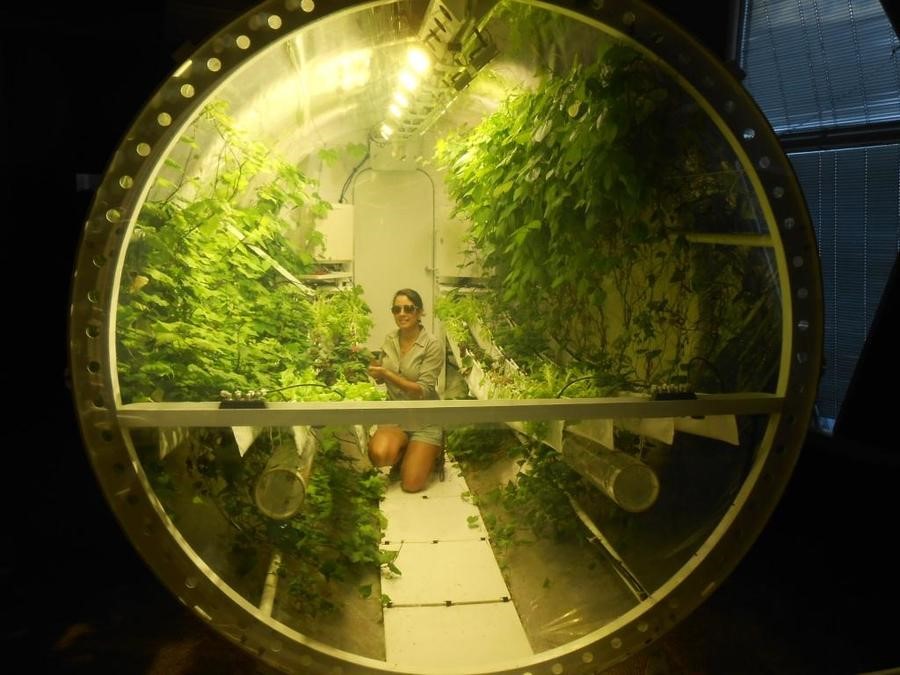The challenges faced by a lone astronaut in the movie “The Martian” has created a new buzz about the Red Planet. But two University of Arizona researchers already have given some thought to the types of fuel needed to keep a new generation of explorers fueled up if they get the chance to reach Mars.
Gene Giacomelli and Roberto Furfaro are technical co-principal investigators on a NASA-funded project started in 2009 to build a fully functional lunar and Martian greenhouse. Giacomelli is also director of the Controlled Environment Agriculture Center in the UA College of Agriculture and Life Sciences while Furfaro is director of the Space Systems Engineering Lab at the university.
Giacomelli and Furfaro recently hosted an AMA ('Ask Me Anything') on Reddit, an online community for sharing posts, links, and news. The following is a sample of some of the questions and responses:
Have you seen “The Martian”? And if so, how accurate are the specific issues he faced and how they were addressed?
Giacomelli: It was enjoyable science fiction with much basis on facts but with the ability to stretch the science/engineering. The potatoes would never have grown in the limited lighting conditions of the habitat. Also, the human waste would have been too “unprocessed” to provide nutrients.
How is Martian soil as a growing medium?
Furfaro: The major problem is reactive nitrogen, which is not generally present in Martian soil. It is OK mineral-wise. Consider that Mars simulant is generally derived from volcanic material. Obviously, you need quite a bit of flowing water.
What grows best on Mars?
Giacomelli: Unsure, never been there. But we grow veggies in ours [Martian Greenhouse] on Earth. In general, all crops “may” grow or at least have the potential to grow but we need to go and try.
We normally say that in hydroponics and controlled environment all plants will grow and grow anywhere the system is placed. But there is the cost that limits each application.
Have plants been tested in space? What effects does the differing gravity from Earth have on how they grow?
Giacomelli: Not on a planet as of yet, but in the Space Station in microgravity, which is much more challenging for growing plants than on a planet surface. Think about how to get the water and nutrients to the root system.
How does less gravity affect the growth of plants?
Giacomelli: With reduced gravity, the irrigation process is more challenging. And the water absorbance by the plant and water movement in the plant are both reduced. At lower air pressures, the gas exchange from the leaves is slowed.
What types of plants are prioritized for production in space and controlled environments, and for what reasons?
Giacomelli: NASA has about 21 favorite crops based on a balanced diet: protein crops (soybeans, wheat), minerals/fiber crops (tomato, lettuce). Actually, algae is a better oxygen producer than most food crops.
What do you think was your greatest achievement so far?
Giacomelli: Besides some of the science/engineering, the interest that has been created by the Mars-Lunar Greenhouse filled with plants, glowing away and growing up a storm. Also, that the greenhouse system demonstrates the water cycle, the carbon cycle and the plant nutrients cycles while in the lab is a simple way to help student learning.
Furfaro: Automating the Mars-Lunar Greenhouse. The environment is controlled as we automatically adjust nutrient feeds and other parameters to maximize biomass productions (e.g., vegetables).
What has been the most significant technical challenge in this experiment?
Furfaro: Demonstrate that one unit of our Mars-Lunar Greenhouse can produce 50 percent of the calories/day needed by one astronaut while completely recycling water and close the oxygen loop.
How were each of those goals frustrating and how did you innovate solutions to those problems?
Furfaro: This is an extremely complex system and achieving our goals is not easy, hence frustration. One thing that we are experimenting is what is called policultivation, or growing combinations of different species of vegetable in the same environment. That is a major challenge as NASA has not studied that before (only mono cultivations for which we have data). Controlling the growing environment in a multi-crop system is challenging especially when you want to maximize production. We are starting working on innovative adaptive control systems that rely on data-driven models of the system.
Is anything from your work being made available for commercial sale here on terrestrial Earth?
Giacomelli: Earth applications are important! Great question! Yes, our work came from previous experiences for on-Earth commercial food-production systems in greenhouses. We plan to use the improvements and new knowledge to feed back to Earth-based food producers in greenhouses and in other indoor systems.
Click here to view the full thread.
Photo Credit: University of Arizona




